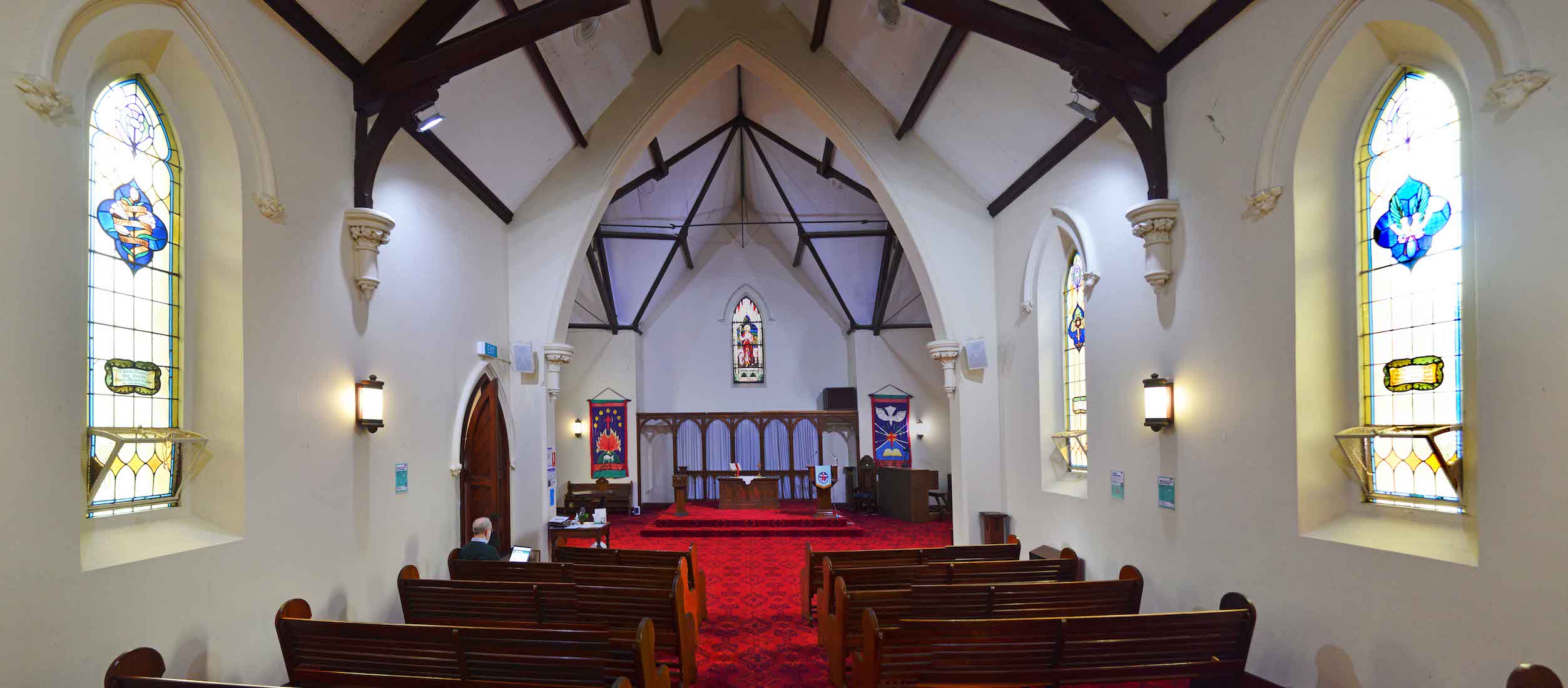

We descend the stairs from the gallery, and return to the narthex. There is a room at the North end, where there is another cabinet with historic items. You can see some of these by clicking / tapping here. INDEX
22. WALL PLAQUE AND WINDOW


Also in this end room is the third West window, and a colourful wall tribute giving a list of names of Christ.
24. CROSS AND CHAIR
The cross is of stained wood, nicely finished, with a red sash draped over it, and two small brass urns below. It is a reminder of the centrality of the crucifixion to the Christian faith. The old chair with its Gothic-style insert, is a much used piece of furniture dating from 1920. It was given in memory of Hubert Llewellyn Tucker who died in 1920.
25. NAVE
From the back of the nave we can look down the centra aisle to the altar. The Church has a pleasant ‘feel’: it is neat and tidy and conducive to worship. We shall see indications that renovations are due with cracks appearing in the walls – a problem with old buildings.
26. SANCTUARY
We shall move to the East end of the Church shortly, but here we notice how the sanctuary is framed by a large pointed Gothic arch. There are small carved corbels at the lower ends of the arch: these are a feature of the interior decoration here.
27. NORTH NAVE
Along the North wall of the nave, East of the balcony, there are two windows, and the door we entered by. The windows demonstrate the style of the time: not plain, not fully stained glass, but featuring a coloured logo of Christian significance. Many of the Lutheran churches in the Barossa Valley have this style of window.
28. SOUTH NAVE
There are three windows along the South side of the nave. As well as the corbels, we notice the small decorated ends of the arches above the windows.
29. WEST NAVE
A glance back to the West end of the nave reminds us of our journey thus far.
30. CAPITAL DECORATION
It is worth looking more closely at the nicely carved leafy decoration of the corbels.
31. NORTH NAVE WINDOWS
The two windows on the North wall of the nave ... . • The window at left depicts a Bible and a lamp. It illustrates Psalm 119:105 – ‘Thy word is a lamp unto my feet.’ The window was given in memory of Thomas Breen. • The window at right shows white lilies with the Beatitude: Blessed are the pure in heart. White lilies are often used in religious art to symbolise purity, particularly relating to the Virgin Mary. This window was given in memory of George and Margaret Davidson.
32. SOUTH NAVE WINDOWS
The windows on the South wall of the nave ... . • The left window shows a tree of life behind a cross with a crown of thorns(?). It was given in memory of David Bell. • The central window shows a victor’s crown and laurel leaves. The picture is of winning a race. 1 Corinthians 9:24 24 – ‘Do you not know that in a race all the runners run, but only one gets the prize? Run in such a way as to get the prize.’ It was given in memory of William Henry and Margaret Dunk. • The window at right shows a cross and crown, symbols of the suffering and kingship of Christ. It was given in memory of James McCord, elder of the Church for many years.
34. HONOURS ROLL AND WINDOW
The roll of honour is nicely carved and bears the names of members of the St Andrew’s congregation who gave their lives in the 1914 – 1919 War. The window has two lancets bearing identical motifs showing a heart, cross and anchor. A reference to the anchor is found in Hebrew’s 6:19. The window is given in memory of Mary Stone, and carries the words of St Paul, ‘For me to live is Christ, and to die is gain.’ (Philippians 1:21)
35. BANNERS
The colourful banner shown at left is on the North wall, and is perhaps a Sunday School banner. It comprises twelve squares showing scenes relating to the Christian life. The other banner, on the East wall, celebrates 150 years of worship at St Andrew’s, from 1844 – 1994 – a great record. The banner incorporates various symbols: seven stars, the cross, a fish, the burning bush, ... . Presbyterians seem to have a special association with the burning bush, symbol of God’s presence, authority, energy, ... .
37. BANNER AND WINDOW
This banner also celebrates the 150 years of worship at St Andrew’s. It‘s symbols include the Bible, the cross, a descending dove bearing a twig, and the text, ‘Jesus now and always’. • The interesting stained glass window is a detailed depiction of the parable of the Good Samaritan (Luke 10:25–37). You might like to search for the pictured details of the story: the priest, the Levite, the Samaritan’s donkey, the oil, wine and moneybag, ... . The window is given in memory of the pioneer families Richardson and Bell.
38. ORGAN
Music for congregational singing is provided by an electronic organ. The little stoup at right is decorative only: made for a Church fair.
40. EAST WINDOW
The East window is an attractive portrayal of Jesus as the Good Shepherd. Below are the words of Jesus, ‘I am the Good Shepherd’ (John 10:11). The window was given in memory of George Graham and Margaret Paterson.



























